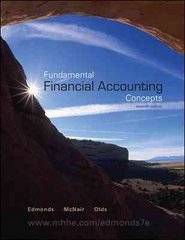Question
The Rohr Companys old equipment for making subassemblies is worn out. The company is considering two courses of action: (a) Completely replacing the old equipment
The Rohr Companys old equipment for making subassemblies is worn out. The company is considering two courses of action:
(a) Completely replacing the old equipment with new equipment or
(b) Buying subassemblies from a reliable outside supplier, who has quoted a unit price of $1 on a 7-year contract for a minimum of 50,000 units per year.
Production was 60,000 units in each of the past 2 years. Future needs for the next 7 years are not expected to fluctuate beyond 50,000 to 70,000 units per year. Cost records for the past 2 years reveal the following unit costs of manufacturing the subassembly:
Per Unit
Direct Materials
$0.30
Direct Labor
0.35
Variable Overhead
0.10
Fixed Overhead (including $0.10 depreciation and $0.10 for direct departmental fixed overhead)
0.25
Total Cost
$1.00
The new equipment will cost $188,000 cash, will last 7 years, and will have a disposal value of $20,000. The current disposal value of the old equipment is $10,000.
The sales representative for the new equipment has summarized her position as follows: The increase in machine speeds will reduce direct labor and variable overhead by $0.35 per unit. Consider last years experience of one of your major competitors with identical equipment. It produced 100,000 units under operating conditions very comparable to yours and showed the following unit costs.
Per Unit
Direct Materials
$0.30
Direct Labor
0.05
Variable Overhead
0.05
Fixed Overhead (including $0.10 depreciation and $0.10 for direct departmental fixed overhead)
0.40
Total Cost
$0.80
For purposes of this case, assume that any idle facilities cannot be put to alternative use. Also assume that $0.05 of the old Rohr unit cost is allocated fixed overhead that will be unaffected by the decision.
Required:
1. The president asks you to compare the alternatives on a total-annual-cost basis and on a per-unit basis for annual needs of 60,000 units. Which alternative seems more attractive?
2. Would your answer to number 1 change if the needs were 50,000 units? 70,000 units? At what volume level would Rohr be indifferent between making and buying subassemblies? Show your computations.
3. What factors, other than the preceding ones, should the accountant bring to the attention of management to assist them in making their decision? Include the considerations that might be applied to the outside supplier.
Step by Step Solution
There are 3 Steps involved in it
Step: 1

Get Instant Access to Expert-Tailored Solutions
See step-by-step solutions with expert insights and AI powered tools for academic success
Step: 2

Step: 3

Ace Your Homework with AI
Get the answers you need in no time with our AI-driven, step-by-step assistance
Get Started


